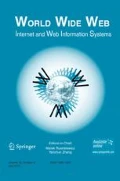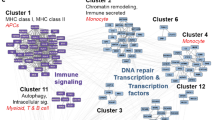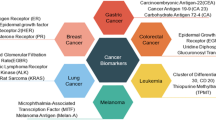Abstract
The neuroimaging genetic study usually needs to deal with high dimensionality of both brain imaging data and genetic data, so that often resulting in the issue of curse of dimensionality. In this paper, we propose a group sparse reduced rank regression model to take the relations of both the phenotypes and the genotypes for the neuroimaging genetic study. Specifically, we propose designing a graph sparsity constraint as well as a reduced rank constraint to simultaneously conduct subspace learning and feature selection. The group sparsity constraint conducts feature selection to identify genotypes highly related to neuroimaging data, while the reduced rank constraint considers the relations among neuroimaging data to conduct subspace learning in the feature selection model. Furthermore, an alternative optimization algorithm is proposed to solve the resulting objective function and is proved to achieve fast convergence. Experimental results on the Alzheimer’s Disease Neuroimaging Initiative (ADNI) dataset showed that the proposed method has superiority on predicting the phenotype data by the genotype data, than the alternative methods under comparison.






Similar content being viewed by others
References
Ballard, D.H., Cho, J., Zhao, H.: Comparisons of multi-marker association methods to detect association between a candiyear region and disease. Genet. Epidemiol. 34(3), 201–212 (2010)
Batmanghelich, N.K., Dalca, A., Quon, G., Sabuncu, M., Golland, P.: Probabilistic modeling of imaging, genetics and diagnosis. IEEE Trans. Med. Imaging 35(7), 1765–1779 (2016)
Bertram, L., McQueen, M.B., Mullin, K., Blacker, D., Tanzi, R.E.: Systematic meta-analyses of Alzheimer disease genetic association studies: the Alzgene database. Nat. Genet. 39(1), 17–23 (2007)
Bralten, J., Arias-Vásquez, A., Makkinje, R., Veltman, J.A., Brunner, H.G., Fernández, G., Rijpkema, M, Franke, B.: Association of the Alzheimer’s gene SORL1 with hippocampal volume in young, healthy adults. American Journal of Psychiatry (2011)
Brun, C.C., Leporé, N., Pennec, X., Lee, A.D., Barysheva, M., Madsen, S.K., Avedissian, C., Chou, Y.-Y., Zubicaray, G.I.D., McMahon, K.L., et al.: Mapping the regional influence of genetics on brain structure variabilitya tensor-based morphometry study. Neuroimage 48(1), 37–49 (2009)
Chételat, G., Eustache, F., Viader, F., De La Sayette, V., Pélerin, A., Mézenge, F., Hannequin, D., Dupuy, B., Baron, J.-C., Desgranges, B.: FDG-PET Measurement is more accurate than neuropsychological assessments to predict global cognitive deterioration in patients with mild cognitive impairment. Neurocase 11(1), 14–25 (2005)
Convit, A., De Asis, J., De Leon, M.J., Tarshish, C.Y., De Santi, S., Rusinek, H.: Atrophy of the medial occipitotemporal, inferior, and middle temporal gyri in non-demented elderly predict decline to alzheimers disease. Neurobiol. Aging 21 (1), 19–26 (2000)
Deng, X., Li, Y., Weng, J., Zhang, J.: Feature selection for text classification: a review. Multimedia Tools Appl., pp. 1–20 (2018)
Du, L., Yan, J., Kim, S., et al.: A novel structure-aware sparse learning algorithm for brain imaging genetics. In: MICCAI, pp. 329–336 (2014)
Evgeniou, A., Pontil, M.: Multi-task feature learning. NIPS 19, 41–48 (2007)
Filippini, N., Rao, A., Wetten, S., Gibson, R.A., Borrie, M., Guzman, D., Kertesz, A., Loy-English, I., Williams, J., Nichols, T., et al.: Anatomically-distinct genetic associations of APOE𝜖4 allele load with regional cortical atrophy in Alzheimer’s disease. Neuroimage 44(3), 724–728 (2009)
Fox, N.C., Schott, J.M.: Imaging cerebral atrophy: normal ageing to Alzheimer’s disease. The Lancet 363(9406), 392–394 (2004)
Gao, L., Guo, Z., Zhang, H., Xu, X., Shen, H.T.: Video captioning with attention-based lstm and semantic consistency. IEEE Trans. Multimedia 19(9), 2045–2055 (2017)
Gao, L., Song, J., Liu, X., Shao, J., Liu, J., Shao, J.: Learning in high-dimensional multimedia data: the state of the art. Multimedia Syst. 23(3), 303–313 (2017)
Guo, Y., Wu, G., Jiang, J., Shen, D.: Robust anatomical correspondence detection by hierarchical sparse graph matching. IEEE Trans. Med. Imaging 32(2), 268–277 (2013)
Guo, Y., Gao, Y., Shen, D.: Deformable mr prostate segmentation via deep feature learning and sparse patch matching. In: Deep Learning for Medical Image Analysis, 197–222 (2017)
Hao, X., Yu, J., Zhang, D.: Identifying genetic associations with MRI-derived measures via tree-guided sparse learning. In: MICCAI 2014, pp. 757–764 (2014)
Hibar, D.P., Stein, J.L., Kohannim, O., Jahanshad, N., Saykin, A.J., Shen, L., Kim, S., Pankratz, N., Foroud, T., Huentelman, M.J., et al.: Voxelwise gene-wide association study (vGeneWAS): multivariate gene-based association testing in 731 elderly subjects. Neuroimage 56(4), 1875–1891 (2011)
Hu, R., Zhu, X., Cheng, D., He, W., Yan, Y., Song, J., Zhang, S.: Graph self-representation method for unsupervised feature selection. Neurocomputing 220, 130–137 (2017)
Huang, M., Nichols, T., Huang, C., Yu, Y., Lu, Z., Knickmeyer, R.C., Feng, Q., Zhu, H.: Alzheimer’s Disease Neuroimaging Initiative, et al. Fvgwas: fast voxelwise genome wide association analysis of large-scale imaging genetic data. Neuroimage 118, 613–627 (2015)
Izenman, A.J.: Reduced-rank regression for the multivariate linear model. J. Multivar. Anal. 5(2), 248–264 (1975)
Joyner, A.H., Bloss, C.S., Bakken, T.E., Rimol, L.M., Melle, I., Agartz, I., Djurovic, S., Topol, E.J., Schork, N.J., Andreassen, O.A., et al.: A common mecp2 haplotype associates with reduced cortical surface area in humans in two independent populations. Proc. Natl. Acad. Sci. 106(36), 15483–15488 (2009)
Kabani, N.J.: 3D anatomical atlas of the human brain. In: Human Brain Mapping (1998)
Lei, C., Zhu, X.: Unsupervised feature selection via local structure learning and sparse learning. pages. https://doi.org/10.1007/s11042-017-5381-7, 11 (2017)
Lin, D., Cao, H., Calhoun, V.D., Wang, Y.-P.: Sparse models for correlative and integrative analysis of imaging and genetic data. J. Neurosci. Methods 237, 69–78 (2014)
Louwersheimer, E., Ramirez, A., Cruchaga, C., Becker, T., Kornhuber, J., Peters, O., Heilmann, S., Wiltfang, J., Jessen, F., Visser, P.J., et al.: The influence of genetic variants in SORL1 gene on the manifestation of Alzheimer’s disease. Neurobiol. Aging 36(3), 1605–e13 (2015)
McCarthy, J.J., Saith, S., Linnertz, C., Burke, J.R., Hulette, C.M., Welsh-Bohmer, K.A., Chiba-Falek, O.: The Alzheimer’s associated 5’ region of the SORL1 gene cis regulates SORL1 transcripts expression. Neurobiol. Aging 33(7), 1485–e1 (2012)
Misra, C., Fan, Y., Davatzikos, C.: Baseline and longitudinal patterns of brain atrophy in MCI patients, and their use in prediction of short-term conversion to AD: results from ADNI. Neuroimage 44(4), 1415–1422 (2009)
Rosenthal, S.L., Wang, X., et al.: Beta-amyloid toxicity modifier genes and the risk of alzheimers disease. Am. J. Neurodegener. Dis. 1(2), 191–198 (2012)
Shen, L., Kim, S., Risacher, S.L., Nho, K., Swaminathan, S., West, J.D., Foroud, T., Pankratz, N., Moore, J.H., Sloan, C.D., et al.: Whole genome association study of brain-wide imaging phenotypes for identifying quantitative trait loci in MCI and AD: a study of the ADNI cohort. Neuroimage 53(3), 1051–1063 (2010)
Shen, L., Thompson, P.M., Potkin, S.G., et al.: Genetic analysis of quantitative phenotypes in AD and MCI: imaging, cognition and biomarkers. Brain Imaging Behav. 8(2), 183–207 (2014)
Shen, F., Xu, Y., Liu, L., Yang, Y., Huang, Z., Shen, H.T.: Unsupervised deep hashing with similarity-adaptive and discrete optimization (2018)
Song, J., Gao, L., Li, L., Zhu, X., Sebe, N.: Quantization-based hashing: a general framework for scalable image and video retrieval. Pattern Recogn. 75, 175–187 (2018)
Stein, J.L., Hua, X., Lee, S., Ho, A.J., Leow, A.D., Toga, A.W., Saykin, A.J., Shen, L., Foroud, T., Pankratz, N., et al.: Voxelwise genome-wide association study (vGWAS). Neuroimage 53(3), 1160–1174 (2010)
Thung, K.-H., Wee, C.-Y., Yap, P.-T., Shen, D.: Neurodegenerative disease diagnosis using incomplete multi-modality data via matrix shrinkage and completion. Neuroimage 91, 386–400 (2014)
Vounou, M., Nichols, T.E., Montana, G.: ADNI discovering genetic associations with high-dimensional neuroimaging phenotypes: a sparse reduced-rank regression approach. Neuroimage 53(3), 1147–1159 (2010)
Wang, H., Nie, F., Huang, H., et al.: From phenotype to genotype: an association study of longitudinal phenotypic markers to Alzheimer’s disease relevant snps. Bioinformatics 28(18), i619–i625 (2012)
Wang, H., Nie, F., Huang, H., et al.: Identifying quantitative trait loci via group-sparse multitask regression and feature selection: an imaging genetics study of the ADNI cohort. Bioinformatics 28(2), 229–237 (2012)
Wang, X., Gao, L., Wang, P., Sun, X., Liu, X.: Two-stream 3d convnet fusion for action recognition in videos with arbitrary size and length. IEEE Transactions on Multimedia (2017)
Weiner, M.W., Aisen, P.S., Jack, C.R., Jagust, W.J., Trojanowski, J.Q., Shaw, L., Saykin, A.J., Morris, J.C., Cairns, N., Beckett, L.A., et al.: The Alzheimer’s disease neuroimaging initiative: progress report and future plans. Alzheimer’s & Dementia 6(3), 202–211 (2010)
Xia, K., Guo, H., Hu, Z., et al.: Common genetic variants on 1p13. 2 associate with risk of autism. Mol. Psychiatry 19(11), 1212–1219 (2014)
Zhang, S., Li, X., Zong, M., Zhu, X., Wang, R.: Efficient knn classification with different numbers of nearest neighbors. IEEE Trans. Neural Netw. Learn. Syst. 29(5), 1774–1785 (2018)
Zheng, W., Zhu, X., Zhu, Y., Hu, R., Lei, C.: Dynamic graph learning for spectral feature selection. Multimedia Tools and Applications, pages. https://doi.org/10.1007/s11042-017-5272-y (2017)
Zheng, W., Zhu, X., Wen, G., Zhu, Y., Yu, H., Gan, J.: Unsupervised feature selection by self-paced learning regularization. Pattern Recognition Letters, page. https://doi.org/10.1016/j.patrec.2018.06.029 (2018)
Zhu, X., Suk, H.-I., Shen, D.: A novel matrix-similarity based loss function for joint regression and classification in AD diagnosis. Neuroimage 100, 91–105 (2014)
Zhu, X., Zhang, L., Zi, H.: A sparse embedding and least variance encoding approach to hashing. IEEE Trans. Image Process. 23(9), 3737–3750 (2014)
Zhu, X., Suk, H.-I., Lee, S.-W., Shen, D.: Subspace regularized sparse multitask learning for multiclass neurodegenerative disease identification. IEEE Trans. Biomed. Eng. 63(3), 607–618 (2016)
Zhu, X., Li, X., Zhang, S.: Block-row sparse multiview multilabel learning for image classification. IEEE Trans. Cybernet. 46(2), 450–461 (2016)
Zhu, X., Li, X., Zhang, S., Ju, C., Wu, X.: Robust joint graph sparse coding for unsupervised spectral feature selection. IEEE Trans. Neural Netw. Learn. Syst. 28 (6), 1263–1275 (2017)
Zhu, X., Li, X., Zhang, S., Xu, Z., Yu, L., Wang, C.: Graph pca hashing for similarity search. IEEE Trans. Multimedia 19(9), 2033–2044 (2017)
Zhu, X., Suk, H.-I., Huang, H., Shen, D.: Low-rank graph-regularized structured sparse regression for identifying genetic biomarkers. IEEE Trans. Big Data 3(4), 405–414 (2017)
Zhu, X., Suk, H.-I., Wang, L., Lee, S.-W., Shen, D.: A novel relational regularization feature selection method for joint regression and classification in AD diagnosis. Med. Image Anal. 38, 205–214 (2017)
Zhu, X., Zhang, S., Li, Y., Zhang, J., Yang, L., Fang, Y.: Low-rank sparse subspace for spectral clustering. IEEE Transactions on Knowledge and Data Engineering (2018). https://doi.org/10.1109/TKDE.2018.2858782
Zhu, X., Zhang, S., Hu, R., Zhu, Y., et al.: Local and global structure preservation for robust unsupervised spectral feature selection. IEEE Trans. Knowl. Data Eng. 30(3), 517–529 (2018)
Acknowledgments
This work was supported in part by NIH grants (EB008374, AG041721, AG049371, AG042599, EB022880). X. Zhu was also supported by the National Natural Science Foundation of China (Grants No: 61573270 and 61876046); the Project of Guangxi Science and Technology (GuiKeAD17195062); and the Guangxi Collaborative Innovation Center of Multi-Source Information Integration and Intelligent Processing. H.I. Suk was also supported by Institute for Information & Communications Technology Promotion (IITP) grant funded by the Korea government (No. 2017-0-00451).
Author information
Authors and Affiliations
Corresponding author
Additional information
Publisher’s Note
Springer Nature remains neutral with regard to jurisdictional claims in published maps and institutional affiliations.
This article belongs to the Topical Collection: Special Issue on Deep vs. Shallow: Learning for Emerging Web-scale Data Computing and Applications
Guest Editors: Jingkuan Song, Shuqiang Jiang, Elisa Ricci, and Zi Huang
Rights and permissions
About this article
Cite this article
Zhu, X., Suk, HI. & Shen, D. Group sparse reduced rank regression for neuroimaging genetic study. World Wide Web 22, 673–688 (2019). https://doi.org/10.1007/s11280-018-0637-3
Received:
Revised:
Accepted:
Published:
Issue Date:
DOI: https://doi.org/10.1007/s11280-018-0637-3




